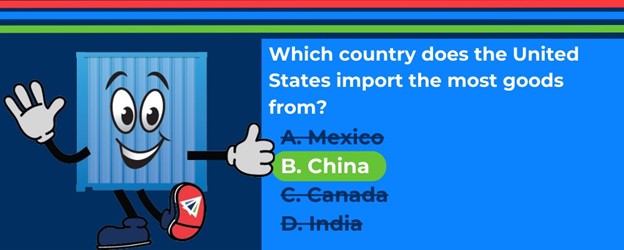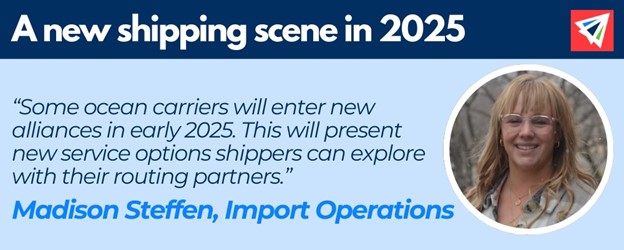Competitive Edge
October 30th, 2024
Stay Current with InterlogUSA
Latest Industry Happenings and Market Updates:
Across International Shipping: News and Developments
[Labor] Port of Montreal Labor Saga Continues: Unionized dockworkers at the Port of Montreal voted to hold another strike scheduled to begin 11 a.m. EDT Thursday. The decision comes promptly after they waged a one-day strike on Sunday. In addition to stoppages, since Oct. 10, dockworkers have also refused overtime work at the port’s facilities.
The dockworker union and maritime employers remain at an impasse over issues of wages, scheduling, and work-life balance.
[Regulation] FMC Cites Progress in Shipper Per Diem Disputes: The U.S. Federal Maritime Commission announced ocean carriers have waived or refunded about $3.2 million in disputed per diem charges imposed against shippers since early 2020.
The figure is relatively modest when compared to the overall charges collected by major carriers, but nonetheless, it still marks a $1.7 million improvement in FMC-assisted refunds and waivers from the same time a year ago.
Increased regulatory monitoring and enforcement is one of the legacies of the pandemic-era shipping crisis.
[Labor] U.S. Longshore Contract Negotiations Resume November: The International Longshoremen’s Association (ILA) and maritime employers at U.S. East and Gulf coasts ports announced they will resume negotiations towards a new dockworker contract in November.
While a tentative deal has already been reached regarding wages, other issues remain at large, including labor assurances against automation. In the meantime, unionized dockworkers will remain working under the terms of their existing labor contract which the two sides agreed to extend through Jan. 15.
IMPORT: Asia to North America (Transpacific Eastbound)
Rates: Rates have relaxed from the beginning of October.
Congestion: Mild congestion related to the longshore strike in early October has diminished. Cargo handling operations at USEC/GC ports are presumed normal.
Space: Post-Golden Week bookings have not strained vessel space on China-U.S. services.
TIPS:
- As the year reaches its end, Q4 can be the right time to get a head start on your 2025 transportation and logistics strategies. While business needs can vary, in most cases, a discussion and evaluation of service providers (carriers, forwarders, Customs brokers, etc.,) should be top of mind, especially as it relates to any potential shortcomings in existing providers throughout 2024.
IMPORT: Europe to North America (Transatlantic Westbound)
2025 Services: Major carriers continue to unveil upcoming changes to their transatlantic offerings, including additional options to the Caribbean and South America.
Rates: Aside from a traditional round of peak season surcharges (PSSs), rates have generally shown little change since August.
Capacity: Available capacity at Europe ports have shown some signs of strain.
EXPORT: North America to Asia
Strong Harvest Season Demand: According to PIERS, a sister product of the Journal of Commerce within S&P Global, in August, the most recent data available, US containerized agricultural exports were up 12.5 percent year over year.
Rates: Outbound rates to Asia from the U.S. East Coast have decreased slightly. Meanwhile, U.S. West Coast to Asia services remain at steady rate levels.
Space: Rail service to the U.S. West Coast has been challenged as increased dwell on import containers delay the pickup of time-sensitive agriculture exports.
Equipment: Slowdowns in equipment placement are being reported at several inland gateways, including Minneapolis and Omaha.
Freight News
U.S. Container Import Volumes in September 2024
Port of Rotterdam Reports 2.2% Increase in Container Volume
In September 2024, U.S. container imports reached 2,520,935 TEUs, just 1.4% below the year’s peak in July, which was 2,556,180 TEUs, and up 1.7% from August’s total of 2,479,284 TEUs – according to Descartes.
Compared to September last year, this month’s volumes represent a substantial year-over-year increase of 14.4% and a 23.5% rise over pre-pandemic levels from 2019. Of note, even with these higher import volumes, transit delays have improved at most major U.S. ports.
Container import volumes at the top 10 U.S. ports saw increases and decreases. Per Descartes data, the ports of Long Beach (up 50,401 TEUs), Charleston (up 13,357 TEUs), and Baltimore (up 6,144 TEUs) reported the largest gains. Conversely, the ports of New York/New Jersey (down 19,731 TEUs), Savannah (down 7,730 TEUs), and Tacoma (down 2,435 TEUs) saw the most significant month-over-month decreases.
Container volume at the Port of Rotterdam rose by 2.2% in the first nine months of this year, handling a total of 10.4 million TEUs. This included 5.4 million TEUs in imports and nearly 5 million TEUs in exports. The port attributes this growth to an increase in consumer spending in Europe following a period of reduced purchasing power.
The port stated in their press release that due to uncertainties because of reroutes around the Cape of Good Hope have led to an early peak season during the summer. While in September, “some services were diverted via other ports. Volumes in Rotterdam were therefore lower this month.”
Did you know? With Johnny Cargo!
The correct answer is China!
While Mexico is the top trading partner with the United States, that distinction represents two-way trade. When it comes to U.S. import volumes alone, China is comfortably America’s number one supplier. Courtesy of data from the Office of the United States Trade Representative, the import value of goods from China totaled $536.3 billion in 2022. After China, Mexico ($454.8 billion) and Canada ($436.6 billion) trailed in second and third place respectively.
InterlogUSA’s chat bot Johnny Cargo sure is an inquisitive soul. However, he doesn’t just ask about industry-related trivia. Johnny also loves to ask supply chain professionals about their shipping arrangements and which areas can benefit from InterlogUSA’s assistance as an end-to-end freight forwarder.
He works around the clock and is always available for conversation.

Sign up for our
industry answers
Our team works to provide valuable, unique, and relevant content to assist you in finding solutions. Sign up now.


